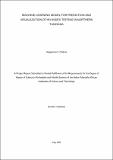| dc.description.abstract | Infection with the human immunodeficiency virus and acquired immunodeficiency syndrome
(HIV/AIDS) continue to pose a threat to Tanzanian society. Various tactics have been used to
improve the number of persons who are aware of their HIV status. Index testing stands out
among these methods as the most effective way to count the number of HIV contacts who may
be at risk of catching HIV from HIV-positive individuals. The current HIV index testing,
however, is manual, which presents a number of difficulties, including inaccuracies, is time consuming, and is expensive to operate. In order to forecast and depict HIV index testing, this
study presents the findings of the machine-learning model. The software development
procedure was in accordance with agile software development principles. The regions of
Kilimanjaro, Arusha, and Manyara in Tanzania are where the data was gathered which
consisted of 11 features and 6346 samples. The dataset was then separated into training sets
with 5075 samples each and testing sets with 1270 samples (80/20). The datasets were
subjected to the methods Random Forest (RF), XGBoost, and Artificial Neural Networks
(ANN). Random forest MAE (1.1261), XGBoost MAE (1.2340), and ANN MAE (1.1268)
were the three results obtained. Random forest algorithms had the lowest mean absolute errors
(MAE). Therefore, RF appearing to have the highest performance when compared to the other
two algorithms. In comparison to men (17.4%), data visualization reveals that females are more
likely to test for HIV and to name their partners (82.6%). Additionally, there were higher
instances of persons listing and mentioning their partners in the Kilimanjaro region. This work
helped us realize the importance of machine learning in predicting and visualizing HIV index
tests in general. The created model can help decision-makers build a viable intervention to stop
the spread of HIV and AIDS in our communities. The report suggests that health centers in
other areas employ this concept to make their work more straightforward. | en_US |

